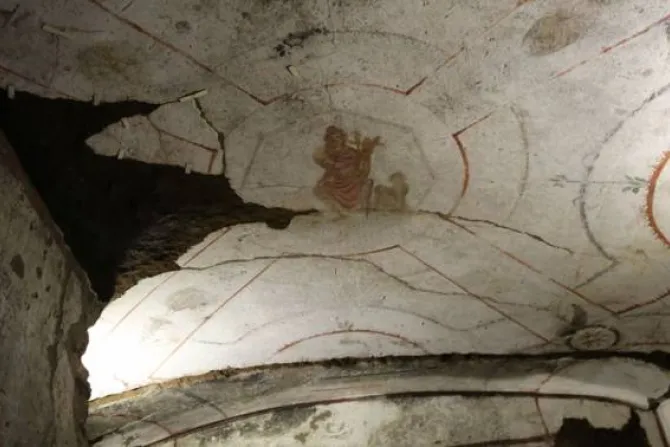Rome, Italy, Jul 20, 2015 / 23:03 pm
A recent discovery in the Catacomb of Saint Callixtus, an early Christian series of tombs beneath Rome which once held the bodies of 16 Popes, has been christened the "Orpheus cubicle" after the figure from Greek mythology.
The small room, located in front of the Crypt of the Popes, was poorly conserved until a recent excavation by the Pontifical Commission for Sacred Archeology. The "Orpheus cubicle" is named for its painting of Orpheus with a lyre, surrounded by birds, sea monsters, and flowers, representing the whole of creation.
Orpheus was a mythological figure known for his musical prowess, able to bring peace through his songs and to enchant nature. He was appropriated by early Christian artists as an image of the Good Shepherd, gathering and protecting the sheep softly with his song.
The image of Orpheus in the Catacomb of St. Callixtus dates from 230-240, and is contemporary with similar images from other Roman catacombs.
Orpheus was also appropriated as a prefigurement of Christ, because after the death of his wife Eurydice he descended into the underworld to try and return her to the land of the living.
The image of Orpheus in St. Callixtus' catacomb has been restored, and in this process the Vatican's archeology commission has also discovered several tombs, more than 300 coins, and fragments of lamps and marble associated with the tombs.
The Catacomb of St. Callixtus was first created during the pontificate of St. Zephyrinus (c. 199-217), by St. Callixtus, a deacon who then succeeded him as Bishop of Rome. The catacomb contains some 500 tombs, and is located on the Appian Way, one of the major roads leading out of Rome.
It once held the bodies of more than 50 martyrs, including St. Cecilia, and Popes from the second to the fourth centuries.
After Christianity became a mainstream religion, the relics within the catacomb were moved to churches for veneration, with the process completed by the ninth century.
The catacomb is now visited by pilgrims and tourists, and the Pontifical Commission for Sacred Archeology has opened the Torreta Museum to house its recent findings associated with the "Orpheus cubicle."


